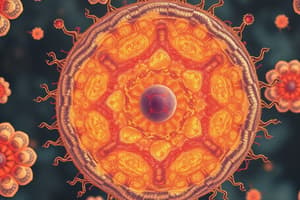Podcast
Questions and Answers
What is the Cell Theory?
What is the Cell Theory?
- All living things are composed of cells.
- Cells are the basic unit of structure and functions in living things.
- All cells come from pre-existing cells.
- All of the above. (correct)
What are organelles?
What are organelles?
Parts in a cell that have different jobs.
What are prokaryotic cells?
What are prokaryotic cells?
Cells that lack a nucleus and most organelles.
What are eukaryotic cells?
What are eukaryotic cells?
What are the key differences between plant and animal cells?
What are the key differences between plant and animal cells?
What is the function of the cell wall?
What is the function of the cell wall?
What does the cell membrane do?
What does the cell membrane do?
What is the role of the nucleus?
What is the role of the nucleus?
What does the nuclear membrane control?
What does the nuclear membrane control?
What is the function of the cytoplasm?
What is the function of the cytoplasm?
What does the E.R. do?
What does the E.R. do?
What is the function of ribosomes?
What is the function of ribosomes?
What does the Golgi apparatus do?
What does the Golgi apparatus do?
What are lysosomes?
What are lysosomes?
What is the cytoskeleton?
What is the cytoskeleton?
What is the function of mitochondria?
What is the function of mitochondria?
What are phospholipids?
What are phospholipids?
What are the two types of transport in cells?
What are the two types of transport in cells?
What is diffusion?
What is diffusion?
What is facilitated diffusion?
What is facilitated diffusion?
What is osmosis?
What is osmosis?
What characterizes an isotonic solution?
What characterizes an isotonic solution?
What characterizes a hypertonic solution?
What characterizes a hypertonic solution?
What characterizes a hypotonic solution?
What characterizes a hypotonic solution?
The four functions of membrane proteins include __________.
The four functions of membrane proteins include __________.
What is active transport?
What is active transport?
What is exocytosis?
What is exocytosis?
What is endocytosis?
What is endocytosis?
What are the two types of endocytosis?
What are the two types of endocytosis?
Flashcards are hidden until you start studying
Study Notes
Cell Theory
- All living organisms are composed of cells; these are the fundamental units of structure and function.
- Cells arise from pre-existing cells, ensuring continuity in living systems.
Cell Timeline
- Electron beam microscopes, including SEM (Scanning Electron Microscope) and TEM (Transmission Electron Microscope), revolutionized cell observation.
Organelles
- Organelles perform various functions within the cell, each playing a distinct role in cellular operation.
Prokaryotic Cells
- Characterized by the absence of a nucleus and most organelles.
- These are the earliest forms of life on Earth.
Eukaryotic Cells
- Contain a nucleus as well as multiple organelles, supporting more complex functions.
Plant vs. Animal Cells
- Animal cells possess centrioles and flagella.
- Plant cells contain chloroplasts, a cell wall, and a central vacuole, contributing to their unique functions.
Cell Wall
- Provides structural support and protection for the cell.
- Facilitates water diffusion in and out of the cell.
Cell Membrane
- Protects the cell by separating internal and external environments.
- Regulates material movement into and out of the cell.
Nucleus
- Acts as the control center for cell activities.
- Houses genetic material necessary for heredity.
Nuclear Membrane
- Manages the exchange of materials between the nucleus and the cytoplasm.
Cytoplasm
- Supports and safeguards cell organelles, providing a medium for biochemical processes.
Endoplasmic Reticulum (E.R.)
- Transports materials within the cell.
- Rough E.R. is studded with ribosomes, while Smooth E.R. lacks them.
Ribosomes
- Responsible for protein synthesis, fundamental for cell functions.
Golgi Apparatus
- Modifies, stores, and directs proteins and products to their respective destinations.
Lysosomes
- Digestive sacs containing enzymes that break down waste and harmful bacteria.
Cytoskeleton
- A framework of fibers that helps maintain the cell's shape and organization.
Mitochondria
- Powerhouses of the cell that convert sugar into energy (ATP).
Phospholipids
- Key components of the cell membrane, featuring hydrophilic heads and hydrophobic tails.
Types of Transport
- Passive Transport: Occurs without energy expenditure.
- Active Transport: Requires energy to move substances against their concentration gradient.
Diffusion
- Process of particles moving from areas of higher to lower concentration until equilibrium is achieved; occurs without energy.
Facilitated Diffusion
- A form of passive transport that uses membrane proteins to assist in the movement of specific substances from high to low concentration.
Osmosis
- A specific type of passive transport focusing on the movement of water through a selectively permeable membrane.
Isotonic Solution
- Achieves equal distribution of solute and solvent across a membrane.
Hypertonic Solution
- Contains a higher concentration of solute, leading to cell shrinkage due to water loss.
Hypotonic Solution
- Has a lower concentration of solute, causing cells to swell as water enters.
Functions of Membrane Proteins
- Enzymatic activity: Accelerate biochemical reactions.
- Cell recognition: Facilitate identification between cells.
- Signal transduction: Allow communication and message transfer within cells.
- Transport: Assist the movement of materials across the membrane.
Active Transport
- Utilizes energy for the movement of molecules from lower to higher concentration; may involve protein pumps or large vesicles.
Exocytosis
- The process of expelling materials from a cell using vesicles.
Endocytosis
- The intake of materials into a cell, also via vesicles.
Types of Endocytosis
- Phagocytosis: Engulfing entire cells or large particles.
- Pinocytosis: Uptake of external fluid and solutes.
Studying That Suits You
Use AI to generate personalized quizzes and flashcards to suit your learning preferences.




